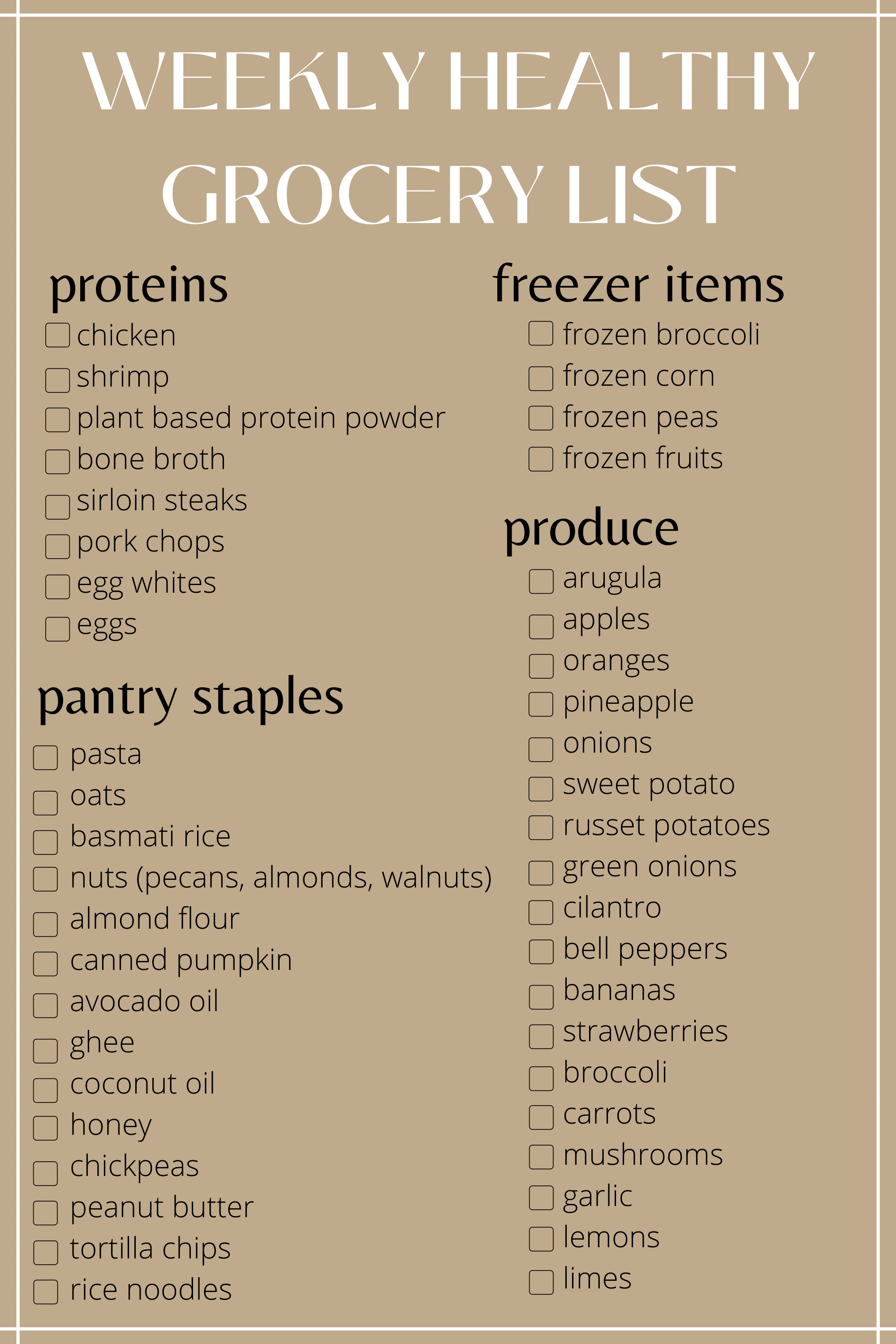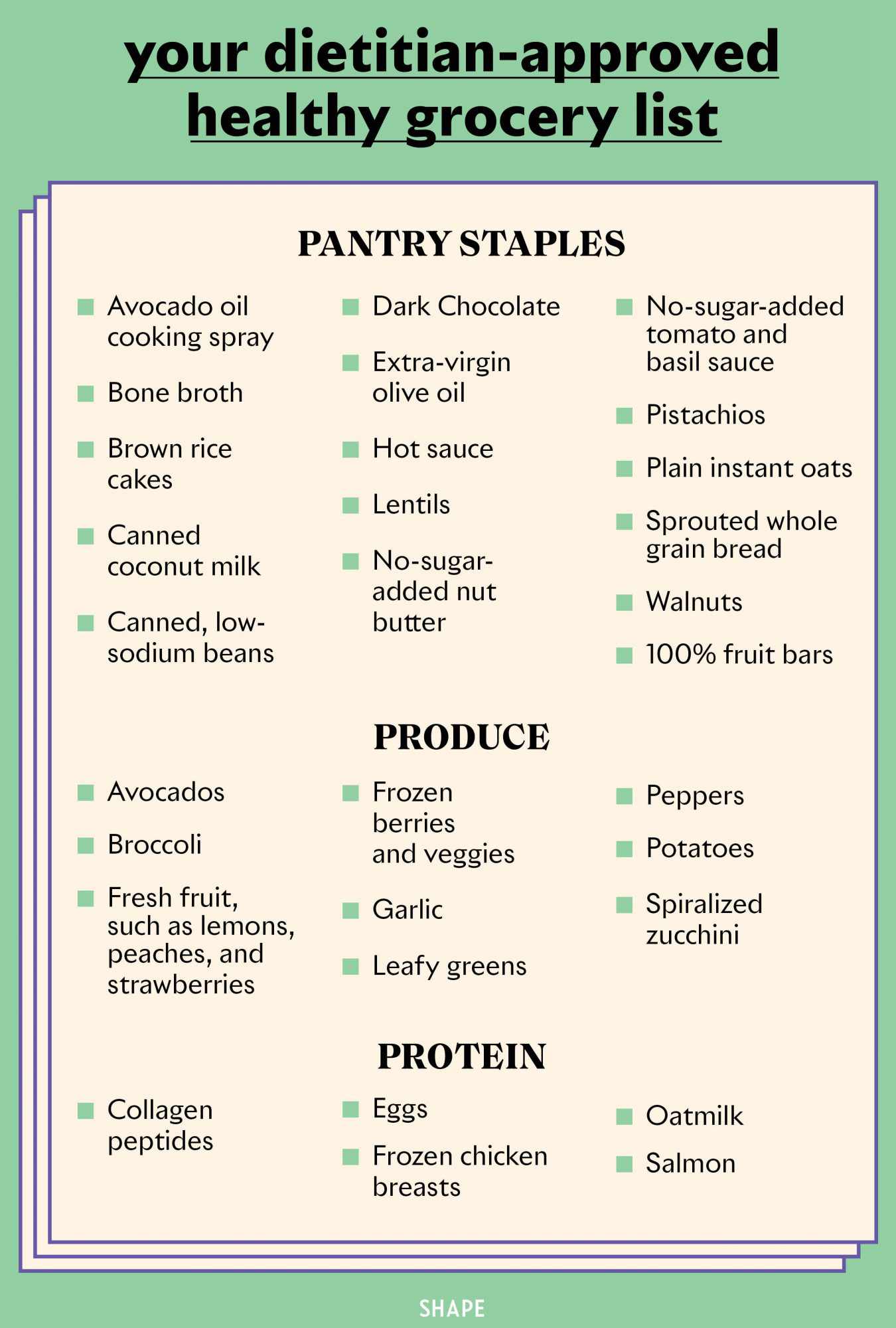How to Eat Healthy Grocery List? To create a healthy grocery list, focus on fresh produce, lean proteins, whole grains, and low-fat dairy. Avoid processed foods and sugary snacks.
Eating healthy begins with smart grocery shopping. Fresh fruits and vegetables should dominate your list, offering essential vitamins and minerals. Lean proteins like chicken, fish, and legumes support muscle health. Whole grains such as brown rice and oats provide sustained energy.
Including low-fat dairy products ensures adequate calcium and vitamin D intake. Healthy fats from sources like avocados and nuts are important for heart health. Reading labels helps you avoid hidden sugars and unhealthy additives. Planning meals in advance can streamline your shopping and prevent impulse buys. Prioritize nutrient-dense foods to support overall well-being and maintain a balanced diet.
Introduction To Healthy Eating
How to Eat Healthy Grocery List? Eating healthy is essential for a happy life. This guide will help you create a healthy grocery list. It will make your shopping easier and your meals healthier.
Why It Matters
Healthy eating keeps your body strong. It gives you energy for the day. It helps prevent diseases like diabetes and heart disease.
Eating well also improves your mood. Good food helps you think clearly. It supports your overall well-being.
Basic Principles
Here are some basic principles for healthy eating:
- Include a variety of foods in your diet.
- Focus on whole foods like fruits and vegetables.
- Choose lean proteins such as chicken, fish, and beans.
- Opt for whole grains like brown rice and oats.
- Limit processed foods and sugary snacks.
| Food Group | Examples | Benefits |
|---|---|---|
| Fruits | Apples, Bananas, Berries | Rich in vitamins and fiber |
| Vegetables | Spinach, Carrots, Broccoli | High in nutrients and low in calories |
| Protein | Chicken, Fish, Beans | Builds and repairs tissues |
| Grains | Brown Rice, Quinoa, Oats | Provides energy and fiber |
Setting Up For Success
Creating a healthy grocery list sets you up for success. It helps you make better food choices. A well-planned list saves time and money. It ensures you buy nutritious foods. Let’s dive into some tips for building a healthy grocery list.
Planning Your Meals
Start by planning your meals for the week. Write down each meal and snack. Include breakfast, lunch, dinner, and snacks. Think about balanced meals. Include vegetables, fruits, proteins, and whole grains.
- Breakfast: Oatmeal with berries
- Lunch: Grilled chicken salad
- Dinner: Quinoa with roasted vegetables
- Snacks: Apples, nuts, carrots
Make a shopping list based on your meal plan. Group items by category. For example, put all produce together. This makes shopping faster and easier. Here is a simple example:
| Category | Items |
|---|---|
| Produce | Apples, Carrots, Spinach |
| Proteins | Chicken, Eggs, Beans |
| Grains | Oatmeal, Quinoa, Whole Wheat Bread |
Reading Nutrition Labels
How to Eat Healthy Grocery List? Nutrition labels provide important information. Learn to read them correctly. Check the serving size first. All information on the label is based on one serving. Look at the calories next. This helps you manage your energy intake.
Pay attention to the ingredients list. Ingredients are listed by quantity. The first ingredient is the most used. Look for whole foods. Avoid ingredients you cannot pronounce.
Check for added sugars. They can sneak into many foods. Aim for foods with little or no added sugars. Also, keep an eye on sodium. Too much sodium can be harmful.
- Check serving size
- Look at calories
- Read ingredients list
- Watch for added sugars
- Monitor sodium levels
By planning your meals and reading nutrition labels, you can create a healthy grocery list. This helps you make better food choices. It ensures you and your family eat nutritious meals every day.
Vegetables And Fruits
Eating healthy starts with a well-planned grocery list. Vegetables and fruits are essential. They provide vitamins, minerals, and fiber. This section helps you choose the best options.
Seasonal Picks
Seasonal vegetables and fruits are fresher and tastier. They are often cheaper too. Here are some seasonal picks for each season:
| Season | Vegetables | Fruits |
|---|---|---|
| Spring | Asparagus, peas, spinach | Strawberries, apricots, pineapples |
| Summer | Tomatoes, cucumbers, zucchini | Watermelons, peaches, berries |
| Fall | Broccoli, carrots, sweet potatoes | Apples, grapes, pears |
| Winter | Kale, Brussels sprouts, leeks | Oranges, kiwis, pomegranates |
Frozen Vs. Fresh
Both frozen and fresh vegetables and fruits have benefits. Fresh produce has a higher nutrient content. It also tastes better. But frozen options are convenient and last longer.
Fresh Produce Benefits:
- Higher in vitamins and minerals
- Better taste and texture
- No added preservatives
Frozen Produce Benefits:
- Longer shelf life
- Convenient and easy to store
- Often cheaper than fresh
Include a mix of both in your grocery list. This ensures variety and ease in meal planning. Always check for added sugars or salts in frozen options.

Credit: brunettecollective.com
Proteins For Power
How to Eat Healthy Grocery List? Proteins are essential for building muscle and keeping you strong. A healthy grocery list should include a variety of protein sources. Here, we focus on lean meats, plant-based options, and seafood selections. These choices will fuel your body and mind.
Lean Meats And Plant-based Options
Lean meats are great for muscle growth. They are low in fat and high in protein. Here are some top choices:
- Chicken Breast: Rich in protein, low in fat.
- Turkey: Perfect for sandwiches and salads.
- Lean Beef: Provides iron and B vitamins.
Plant-based options offer protein without animal products. They are also rich in fiber. Some good picks include:
- Tofu: Versatile and easy to cook.
- Lentils: Great for soups and stews.
- Chickpeas: Ideal for salads and hummus.
Seafood Selections
Seafood is another fantastic protein source. It also provides omega-3 fatty acids, which are good for your heart. Consider adding these to your grocery list:
- Salmon: High in protein and omega-3s.
- Tuna: Convenient and versatile.
- Shrimp: Quick to cook and delicious.
Here’s a quick comparison of different protein sources:
| Protein Source | Protein Content (per 100g) | Other Benefits |
|---|---|---|
| Chicken Breast | 31g | Low in fat, high in B vitamins |
| Tofu | 8g | Rich in calcium and iron |
| Salmon | 20g | High in omega-3 fatty acids |
Whole Grains And Carbohydrates
How to Eat Healthy Grocery List? Eating healthy involves making smart choices, especially with grains and carbohydrates. Whole grains and healthy carbs provide essential nutrients and energy. This section will guide you on how to incorporate them into your grocery list.
Choosing Whole Grains
Whole grains are packed with fiber, vitamins, and minerals. They help in digestion and keep you full longer. Here are some examples of whole grains to add to your grocery list:
- Oats: Great for breakfast or baking.
- Brown Rice: A healthier alternative to white rice.
- Quinoa: Rich in protein and easy to cook.
- Whole Wheat Bread: Choose breads labeled “100% whole wheat.”
- Barley: Perfect for soups and stews.
Always check labels to ensure they are whole grains, not refined grains. Whole grains have more nutrients compared to refined grains.
Limiting Processed Carbs
Processed carbs often contain added sugars and unhealthy fats. They can lead to weight gain and other health issues. Here are some processed carbs to avoid or limit:
- White Bread: Lacks fiber and nutrients.
- Sugary Cereals: High in sugar and low in nutrition.
- Pastries and Cakes: Often contain trans fats and added sugars.
- White Pasta: Opt for whole grain or vegetable-based pasta.
- Chips and Crackers: Usually high in sodium and unhealthy fats.
Choose whole grain alternatives to keep your diet balanced and nutritious. Always read labels to understand what you are consuming.
Here’s a quick comparison table to help you choose better:
| Whole Grains | Processed Carbs |
|---|---|
| Oats | White Bread |
| Brown Rice | Sugary Cereals |
| Quinoa | Pastries |
| Whole Wheat Bread | White Pasta |
| Barley | Chips |
Making smart choices with grains and carbs can improve your overall health. Start today by choosing whole grains and limiting processed carbs.
Dairy And Dairy Alternatives
Eating healthy includes making smart choices about dairy and dairy alternatives. These foods are rich in calcium and protein, which are essential for strong bones and muscles. But, not all dairy products are created equal. Opting for low-fat or non-dairy options can help you maintain a balanced diet.
Low-fat And Non-dairy Choices
Low-fat dairy products are lower in saturated fat. This makes them a healthier choice for your heart. Choose products like low-fat milk, cheese, and yogurt. Non-dairy alternatives are great for people who are lactose intolerant or vegan. Options include almond milk, soy milk, and coconut milk.
| Product | Benefits |
|---|---|
| Low-fat Milk | Lower in calories and saturated fat |
| Almond Milk | Rich in Vitamin E and low in calories |
| Soy Milk | High in protein and low in cholesterol |
| Coconut Milk | Good source of healthy fats |
Yogurt And Cheese
Yogurt is a fantastic source of probiotics. These are good for your gut health. Choose low-fat or Greek yogurt for more protein. Add fresh fruits for a tasty snack.
Cheese can be part of a healthy diet, too. Opt for low-fat cheeses like mozzarella, feta, or cottage cheese. These are lower in saturated fat and calories.
- Low-fat Yogurt: More protein, fewer calories.
- Greek Yogurt: High in protein and probiotics.
- Low-fat Cheese: Less fat, same great taste.
- Mozzarella: Lower in fat, good for snacking.
- Feta: Tangy and lower in fat.
- Cottage Cheese: High in protein, low in fat.
Making smart choices in dairy and its alternatives helps you stay healthy. Include these options in your grocery list for a balanced diet.
Fats And Oils
When creating a healthy grocery list, fats and oils play a vital role. They provide energy, support cell growth, and protect organs. Choosing the right types of fats and oils can make a significant difference in your overall health.
Healthy Fats
Healthy fats are essential for your body. They help absorb vitamins and provide energy. Here are some sources of healthy fats:
- Avocados: Rich in monounsaturated fats.
- Nuts and seeds: Full of omega-3 fatty acids.
- Olive oil: Great for cooking and salads.
- Fatty fish: Packed with essential fatty acids.
Limiting Saturated And Trans Fats
Saturated and trans fats can be harmful to your heart. Limiting them is crucial for maintaining good health. Here are some tips:
- Avoid processed foods: They often contain trans fats.
- Choose lean meats: Reduce intake of saturated fats.
- Read labels: Look for low-fat options.
- Cook at home: Control the amount of fat used.
Below is a simple table to help you choose the right fats and oils:
| Healthy Fats | Limit These Fats |
|---|---|
| Avocados | Butter |
| Nuts and seeds | Margarine |
| Olive oil | Processed snacks |
| Fatty fish | Fatty cuts of meat |
Remember, not all fats are bad. Including healthy fats and limiting unhealthy ones can lead to a balanced diet. Make smart choices and your body will thank you.

Credit: everydaywithmadirae.com
Snacks And Beverages
Snacks and beverages play a crucial role in a healthy diet. Choosing the right options ensures you stay energized and hydrated throughout the day. Here, we’ll explore some nutritious snacking ideas and tips for staying well-hydrated.
Healthy Snacking
Healthy snacks can curb hunger between meals and provide essential nutrients. Keep your pantry stocked with these wholesome choices:
- Fresh Fruits: Apples, bananas, berries, and oranges are great options.
- Nuts and Seeds: Almonds, walnuts, and chia seeds offer protein and healthy fats.
- Vegetable Sticks: Carrot and celery sticks pair well with hummus.
- Whole-Grain Crackers: Choose those with minimal added sugars.
- Yogurt: Opt for plain, low-fat, or Greek yogurt for a protein boost.
Staying Hydrated
Proper hydration is essential for overall health and well-being. Here are some beverage choices to keep you hydrated:
| Beverage | Benefits |
|---|---|
| Water | Zero calories, essential for bodily functions |
| Herbal Teas | Hydrating and often contain beneficial antioxidants |
| Coconut Water | Natural electrolytes, great for post-exercise |
| Infused Water | Add fruits or herbs for flavor without added sugars |
Remember, avoiding sugary drinks helps maintain a healthy weight. Prioritize water and nutrient-rich beverages to support your overall health.
Shopping Tips And Tricks
How to Eat Healthy Grocery List? Creating a healthy grocery list can be a game-changer for your diet. Smart shopping helps you stick to nutritious choices. Here are some shopping tips and tricks to make the most of your grocery trips.
Budget-friendly Choices
Eating healthy doesn’t have to be expensive. Here are some budget-friendly tips:
- Buy in bulk: Items like rice, beans, and oats are cheaper in bulk.
- Shop seasonal produce: Seasonal fruits and veggies are more affordable and fresher.
- Choose store brands: Generic brands often offer the same quality at a lower price.
Consider frozen fruits and vegetables. They are nutritious and cost less. Plan your meals around sales and discounts. This saves money and reduces waste.
Avoiding Impulse Buys
Impulse buys can derail your healthy eating goals. Follow these steps to stay on track:
- Make a list: Write down everything you need before shopping.
- Stick to the list: Avoid buying items not on your list.
- Shop on a full stomach: You are less likely to buy junk food when you’re not hungry.
Stay focused in the store. Avoid aisles with snacks and sweets. Bring a friend to help you stick to your plan.
| Shopping Tips | Benefits |
|---|---|
| Buy in bulk | Save money and reduce packaging |
| Shop seasonal produce | Get fresher and cheaper items |
| Make a list | Avoid unnecessary purchases |
| Shop on a full stomach | Reduce impulse buys |
Following these tips will help you shop smartly and eat healthily. Create a plan, stick to it, and enjoy nutritious meals.
Putting It All Together
How to Eat Healthy Grocery List? Eating healthy starts with a well-planned grocery list. This list ensures you buy nutritious foods. It also helps you avoid unhealthy temptations. Below, we provide a sample grocery list. We also discuss adapting it to different dietary needs.
Sample Grocery List
This sample grocery list includes items for balanced meals. It covers all food groups and focuses on whole, unprocessed foods.
| Category | Items |
|---|---|
| Fruits | Apples, Bananas, Berries, Oranges |
| Vegetables | Broccoli, Spinach, Carrots, Bell Peppers |
| Proteins | Chicken Breast, Tofu, Eggs, Lentils |
| Whole Grains | Quinoa, Brown Rice, Whole Wheat Bread |
| Dairy/Alternatives | Greek Yogurt, Almond Milk, Cheese |
| Snacks | Nuts, Seeds, Hummus, Rice Cakes |
Adapting To Dietary Needs
Everyone has unique dietary needs. Here are some tips for adapting the grocery list:
- Vegetarian: Replace chicken with more tofu or beans.
- Vegan: Choose plant-based milk and yogurt.
- Gluten-Free: Opt for gluten-free grains like quinoa.
- Low-Carb: Focus on leafy greens and proteins.
Use this guide to create a healthy, customized grocery list. It helps you stay on track with your nutrition goals.

Credit: www.pinterest.com
Frequently Asked Questions
What Is A Healthy Grocery List Of Foods?
A healthy grocery list includes fresh fruits, vegetables, lean proteins, whole grains, nuts, seeds, and low-fat dairy products.
Can You Give Me A List Of Healthy Food?
Sure, here’s a list of healthy foods: leafy greens, berries, nuts, fish, whole grains, and lean meats. Eat fresh fruits and vegetables daily. Include legumes, seeds, and healthy fats like olive oil. Drink plenty of water.
What Are The 7 Types Of Food You Need To Eat To Stay Healthy?
To stay healthy, eat these 7 types of food: fruits, vegetables, whole grains, lean proteins, dairy, nuts, and seeds. Choose a variety of these foods daily.
What Is A Perfect Grocery List?
A perfect grocery list includes fresh produce, proteins, dairy, grains, and pantry staples. Plan meals and avoid impulse buys.
Conclusion
Creating a healthy grocery list is simple and impactful. Prioritize fresh produce, lean proteins, and whole grains. Choose nutrient-dense snacks and stay hydrated. This approach supports a balanced diet and long-term health. Remember, small changes can make a big difference.
Happy shopping and enjoy your journey to better health!




Leave a Reply